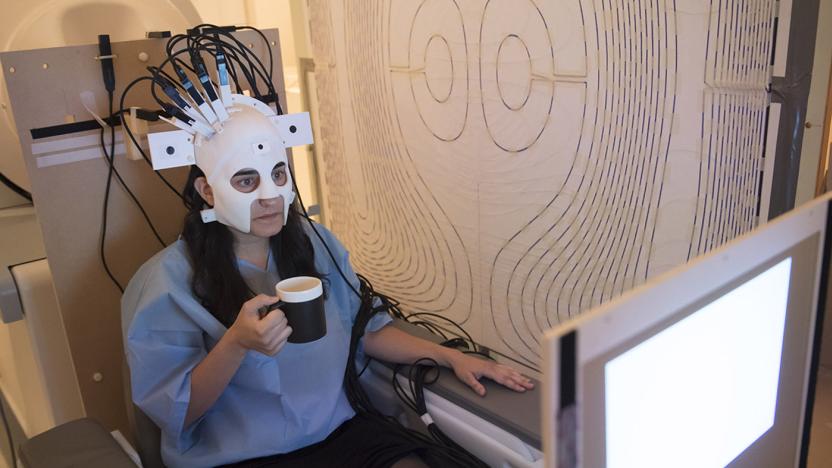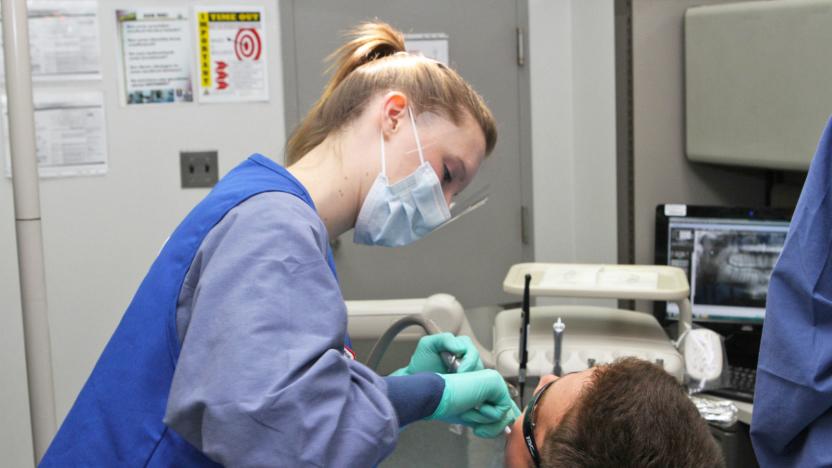universityofnottingham
Latest

This funky helmet makes brain-scanning more comfortable
See that helmet in the photo up there? That's not a prop for a new sci-fi/horror flick -- it's a magnetoencephalography (MEG) helmet that can scan the brain and map its activity. MEG machines are used to look for pathological activity in patients with epilepsy and for brain tumor patients' surgical planning. The machines are typically, humongous, heavy and can't do their job if subjects don't stay perfectly still, which means it's hard to scan kids with epilepsy or people with Parkinson's and other movement disorders. This helmet designed by scientists from the University of Nottingham and University College London will work even if the patient is moving.

Universe may hold 10 times more galaxies than once thought
The observable universe was already incomprehensibly big, but it now looks to be even bigger. Astronomers have determined that are likely about 10 times more galaxies than previously thought, or between 1 trillion to 2 trillion. We just don't have the technology (or physical proximity) to detect them all, according to the researchers. They reached the conclusion after converting Hubble Deep Field images into 3D to study the number of galaxies at a given point in the universe's history, and using mathematical models to infer the possibility of galaxies that we haven't spotted. Simply speaking, the volume of galaxies seen over time doesn't make sense unless there are many we aren't aware of.

Dolly the sheep's clones are healthy, thank you
When Dolly the cloned sheep fell victim to premature aging, lung disease and osteoarthritis, that triggered many fears. Is cloning safe? Would her fellow clones also meet an early end? Apparently, you can relax. A University of Nottingham study shows that four of Dolly's genomic clones (Daisy, Debbie, Denise and Dianna) are healthy, with no conditions that suggest they're aging too quickly. Some showed early signs of osteoarthritis, but that's normal for their advanced age. In short: cloning, if all goes well, is safe.

ICYMI: Space foam party and mind reading for horses
try{document.getElementById("aol-cms-player-1").style.display="none";}catch(e){}Today on In Case You Missed It: A new rover concept from Harvard's SSR Lab shows a rover extruding a fast-drying foam over rocks to keep vehicles from getting stuck on other planets. University of Nottingham researchers are building an algorithm to read the moods and behavior of horses, rather than having behaviorists analyze videos on their own. You should also see this video of hardware playing a very iconic song, at least check out the hysteria around Pokemon Go, and what's going on with Mars. As always, please share any interesting tech or science videos you find by using the #ICYMI hashtag on Twitter for @mskerryd.

Regenerative tooth fillings could put an end to root canals
You really don't want a root canal, and not just because it's potentially painful. Emptying the tooth of the infected tissue at its heart potentially weakens it, since you can't grow that organic material back or put toxic fillings in its place. Researchers may have a solution, though. They've crafted fillings that get the tooth's own stem cells to regenerate and repair tissue. This doesn't mean that your pearly whites would return to normal, but the substance could heal the tooth enough to spare you a root canal or prevent fillings from going south.

3D-printed 'dough' helps fix your fractured bones
One day, you might not have to spend ages waiting for broken bones to heal. Researchers have developed a 3D-printed, dough-like biomaterial that could fill large bone fractures while aiding the recovery process. The porous chemical blend can withstand the same abuse as the spongy parts of your longer bones while still letting cells and proteins through -- it even could release its own proteins to speed up your treatment.

Ancient eye potion proves highly effective against MRSA superbug
What do you get when you mix leeks, garlic, wine and bull gall, then ferment it in a copper pot for nine days? In the Anglo-Saxon era, this concoction made a terrific treatment for eye styes but recently researchers have found it equally effective against the scourge of modern medicine: antibiotic-resistant MRSA "superbugs." Freya Harrison, a microbiologist at the University of Nottingham, UK working with Dr Christina Lee, an Anglo-Saxon expert from the School of English, found the ancient recipe in Bald's Leechbook, an Old English medical compendium. The two decided to test its against modern skin infections. Using the oldest heirloom vegetable varieties she could find, Harrison brewed up the recipe, then let it stand the requisite time. What she poured out displayed some incredible antibiotic characteristics.

Researchers find space travel prolongs the life of worms
We've seen research that suggests prolonged space travel could have some adverse effects on the human body, but it looks like there could be some real benefits as well. As BBC News reports, a new study conducted on Caenorhabditis elegans worms sent to the International Space Station has revealed evidence that the trip to space actually slowed their aging process. Specifically, researchers from the University of Nottingham and others institutions part of the ICE-First project found that the time in space reduced activity in a group of genes that have been shown to prolong the worms' lifespan when suppressed on earth. Of course, these are worms we're talking about, but this particular species is often used for such research due to its biological similarities to humans, so the discovery could well lead to more insight into how we age in space as well. Those curious can find the full paper linked below.

Periodic table blasted onto a single human hair using ions, human reportedly wants his hair back
We've seen the Torah inscribed on a surface the size of a pin, and the atomic pen making inroads into even more impressive feats, but tiny writing never ceases to amaze us. Now, it seems, the entire periodic table of the elements has been scribed onto a single hair -- that of Martyn Poliakoff, Professor of Chemistry at the University of Nottingham. The project involved magnifying the hair under an electron microscope, and 'writing' on it with ions using an ion beam writer to imprint the entire table of elements onto the hair. As you'll see in the video after the break, the results are quite impressive albeit very small.

What would happen if you put your hand in the Large Hadron Collider? Er, well, um... (video)
Scientists, they've made our lives infinitely easier, healthier, and longer, but sometimes even their giant intellects can be stumped. Here we have a perfect example of such a scenario, where the seemingly innocuous question of what might happen if one were to dip a hand inside the Large Hadron Collider has generated a wide range of hypotheses, none of which sound particularly assured of being correct. The trouble is that, aside from the known unknowns -- such as whether the accelerated protons would crash and explode upon contact with your hand or just pass through -- there are surely unknown unknowns that will likely become apparent only once you try to do the act itself. So, any volunteers?

Sonic 'laser' developed, makes quite an impression at 80s night
A researcher from the University of Nottingham and his Ukrainian colleague have built the world's first Saser: a device that generates a highly concentrated beam of sound waves at terahertz frequency. Not unlike the frenetic warblings of Welsh chanteuse Bonnie Tyler, when alternating layers of aluminum arsenide and gallium arsenide are exposed to an intense beam of light, photons are released, causing them to bounce back and forth between the layers. Eventually the sound waves combine into much stronger, highly concentrated sounds in which every particle is synchronized -- creating an ultra-high frequency "phonon" beam. Although practical applications for this technology have yet to be developed, it is hoped that Sasers could someday be used to probe and manipulate electronic devices at the nanoscale level, with results that include terahertz-frequency processors which would make the "computers of the future" a thousand times faster. Video after the break.[Via Gizmag]




